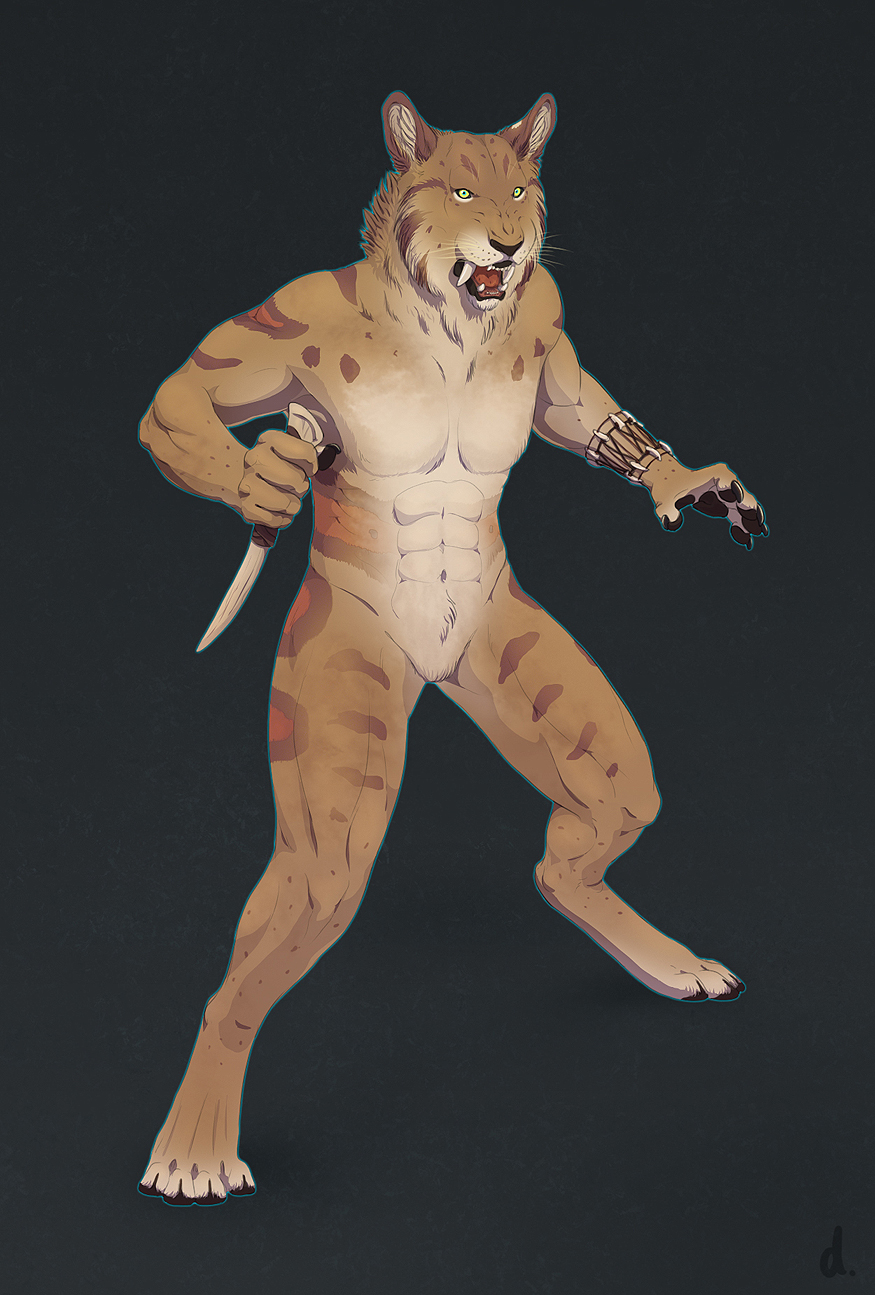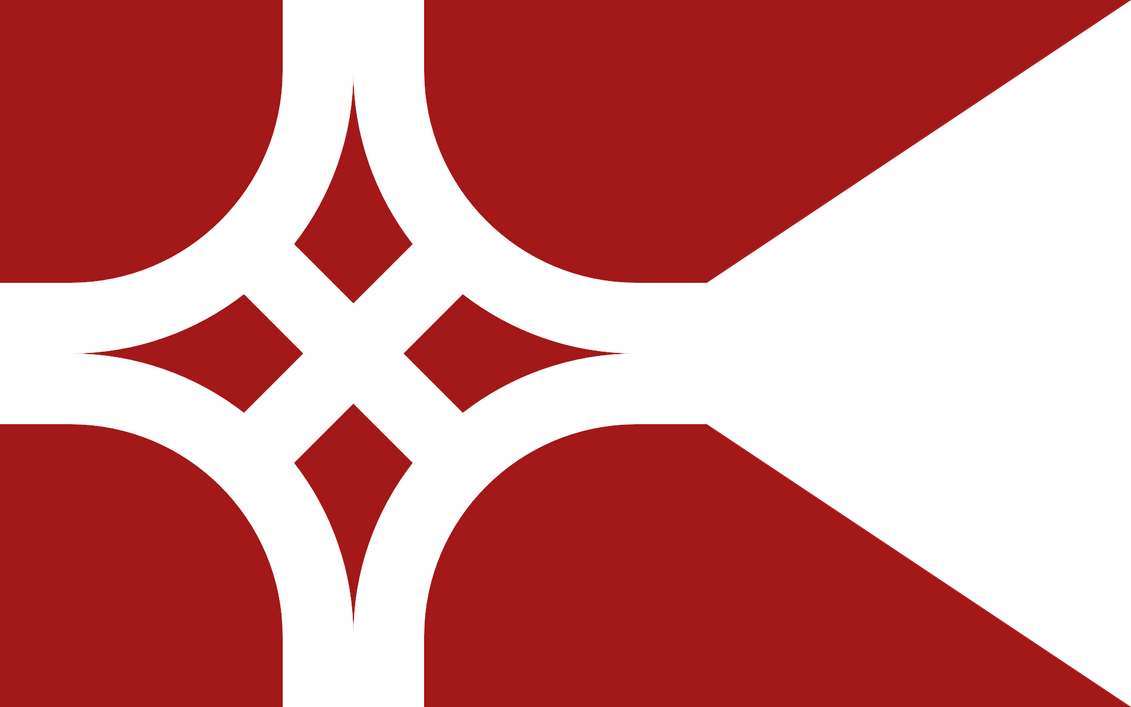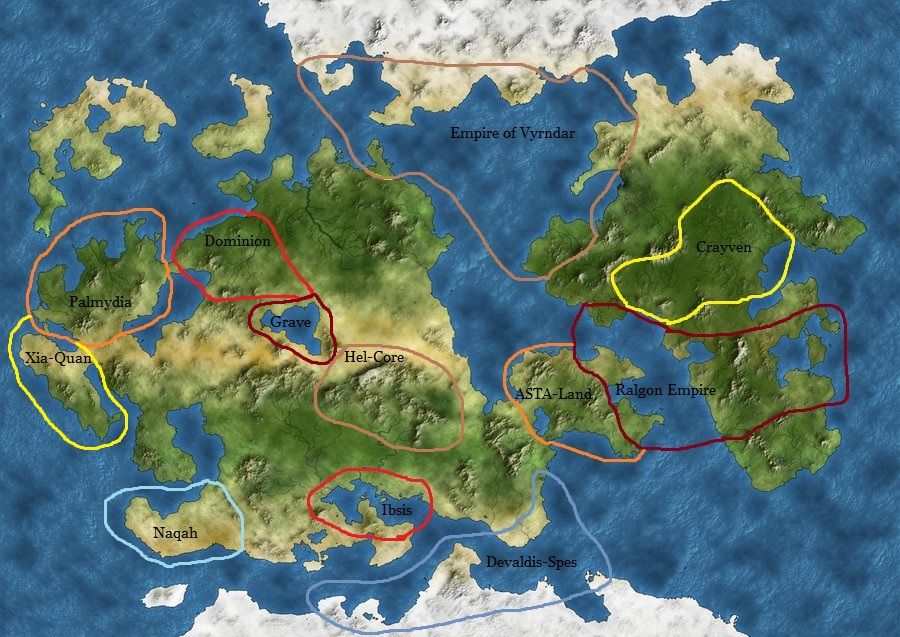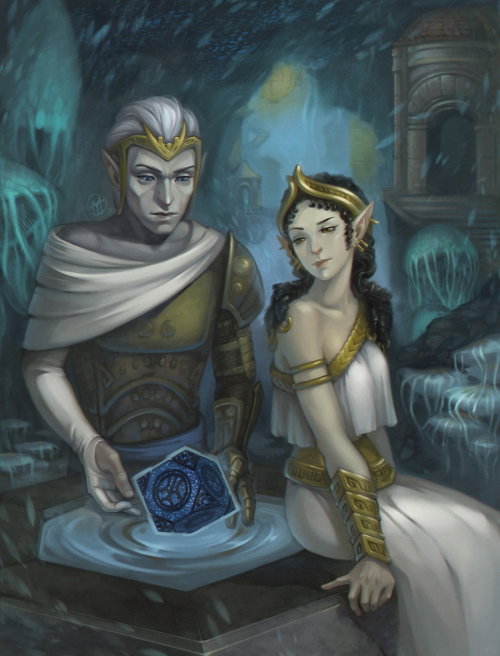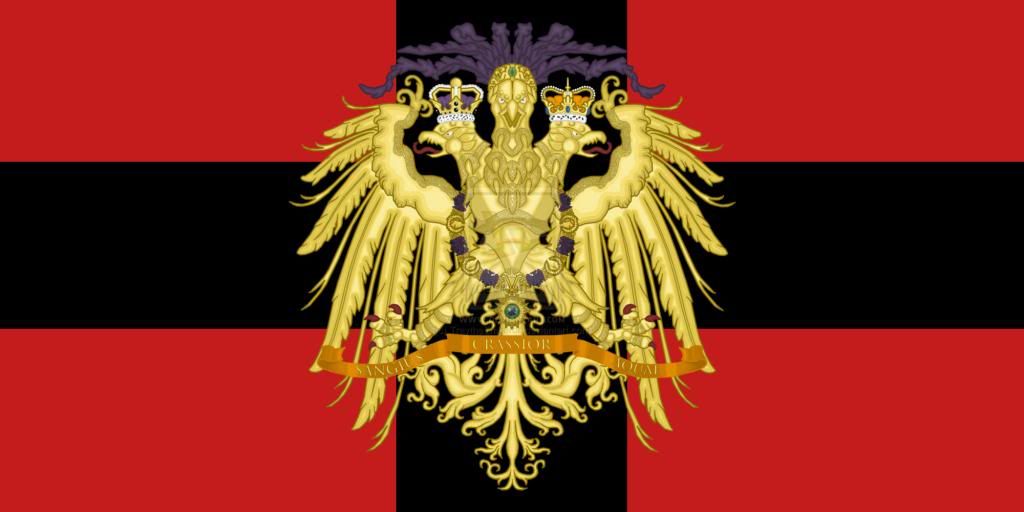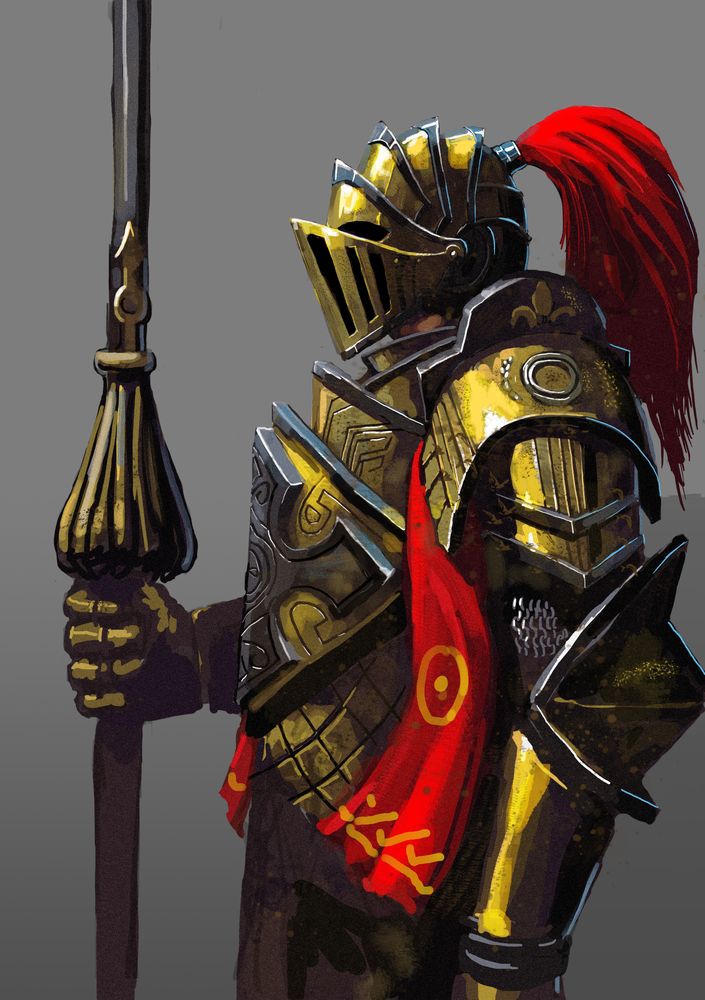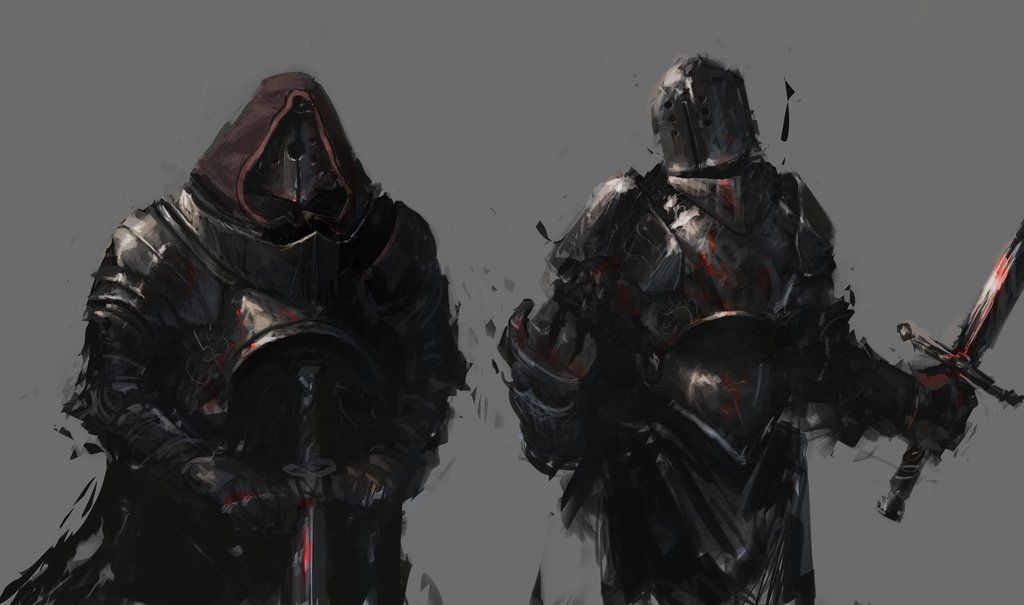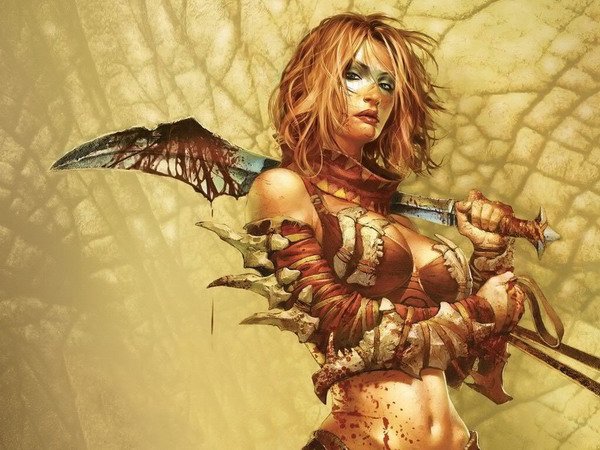Nation Name: The Free Republic of Devaldis-Spes
Flag:
The red sun represents the Red Sun of the Father, which guided the Daemorexa's mythological ancestors through the deserts and forests of wildmen to their promised land.
The green, yellow and blue represents the various stages of their mythological exodus from the Garden of Before. Green being the Garden of Before and the forests and jungles and plains dotted with wildmen, yellow being the desert and blue being the sea they crossed.
Region on map:  Capital:
Capital: Devaldis-Spes (Or Devaldis for short. Translates to City of Hope)
Capital Population: 45,666
Other Major Settlements: Chordum Dastu (roughly translated to Second City built after the aftermath)
Population: 1,321,666
Racial demographics:90% Daemorexa
5% Daemorexiacs
5% Humans
Social dynamics: The Daemonrexa values personal freedom highly, and as such, Daemonrexa society is highly liberal. Therefore, it is expected of anyone existing within their society to allow another to exercise their free will. Conversely, to act against someone's free will or to deprive him/her of that free will is considered a grave crime. As such, societal norms are highly flexible in that there are few societal norms. The only consistent thing is this backbone of freedom which cannot be violated, something that the Daemonrexa would defend viciously and exact disproportionate punishment if there is any such transgression.
This veneration of freedom can be traced back to the mythological founding of their people - their ancestors were said in their myths to have been cast out of the Garden of Before because their tormentors were unable to stomach their differences and newly gained ability to leave the Garden of Before. On their journey to their new found land, they were consistently attacked by bands of wildmen seeking to enslave them or pillage them whether they were migrating south or attempting to settle down. In recent years, this is further reinforced by pirate ships attacking Daemonrexa tradeships bound for coastal tribal villages or sea raiders attempting to breach their defenses.
Fashion: The majority of Daemonrexa prefers nakedness to clothes, seeing their body as the ultimate fashion. There are some, however, that took a liking to clothes, and even then, many prefer form-fitting, tight clothing that are sometimes made of translucent snoworm silk. Beyond this, clothes are used for practical purposes. Strips of cloth are used by both sexes sometimes, especially during vigorous activities, though it is down to individual preference. To traverse out in the cold, thick coats made of Netherbear fur is worn (for example). Those serving in the military would have uniforms (usually just an armband or tabard) and equipment.
Calendar: The Daemonrexa bases the start of their calender on the birth of their first lady and the birth of their first man, both occasions of which are celebrated with festivals involving feasts, orgies, art and plays. This is then followed by the solemn festival of their expulsion, then the founding of their nation.
Art: Daemonrexa tend to be self-absorbed, and thus most of their art is centred around their own body - whether it be sculptures or murals, or tattoos and body modification. Just as important to them, however, is art depicting their mythological rise and history. Art depicting more recent events are considered avant-garde. In the field of literature, fictional stories, epics and the transcription of what was previously only oratory traditions are also their avant-garde.
Law: Like their society, Daemonrexa law is flexible with a hard backbone. Anything done in the name of free will can be done, and legalised, provided that it is justified. This includes even slavery (as contradictory as it seems), torture, execution, child-adult or child-child relationships in addition to what would be considered progressive today, such as same-sex unions, the handing over of a council seat from a corrupt politician to a caretaker, etc.
The legal proceedings, however, is far from flexible. Trials are meticulously held, as are witnesses, evidence, followed by debates and discussions. That said, the main reason why a person lost a case and paid harshly for it is because he is found to have done something to deprive the free will of another. Cases are considered extremely serious, as punishments are often meted out based on the severity of the transgression. Punishments are often an eye for an eye, but adjusted for maximum utility to the state and maximum suffering. Pirates, pillagers and slavers are often enslaved (enslaved humans will be shackled until they became Daemonrexiacs) or in the worst cases, tortured and executed. Rapists are sent off to brothels and pain chambers while murderers to arenas. Punishments can also be determined by the victims - in minor cases, this is almost always a certainty, but victims could appeal for this right in major cases. Victims could appeal for temporary enslavement or payment, among other things, from the transgressors.
Education: Public education revolves mainly around the passing on of mythology, history and lore to the children. Everything else is learnt privately (homeschooled), or through a tutor (some have become professional teachers to cater to parents who prefer this mode of education). Apprenticeship provides for tertiary education, whether be it in the field of a tutor itself, or as a blacksmith, farmer or harlot, etc.
Type of Government: The government of Devaldis-Spes is best described as a republic dominated by populists. The most influential and popular individuals are allowed to make decisions - these individuals would form a council. Each city, town and village would have their own council. As cities tend to be the most populous places, city councils and their rulers tend to be the most powerful. The most prominent member of a city/town/village council is made the head Councillor. Therefore, the head Councillor of the titular capital of the Free Republic of Devaldis-Spes is the leader of the country, known as the Sovereign.
The size of a council depends on the size of a settlement, with the number of councilors per number of citizens bigger the smaller a settlement. A village would have one councilor for every 100 citizens, while a town would have a councilor for every 250 citizens, and a city one for every 500. Devaldis-Spes herself would thus have 91 councilors.
Anyone, be it man or woman, child (yes, there were a few isolated cases of extremely prodigious children taking seats in government) or adult, regardless of sexual orientation or race (there were cases of Daemonrexiacs holding important posts) or any other preferences or physical features or point of differences, may hold a seat. Referendums are held every year as a check on the popularity of a leader. Should leaders do something that would make their leadership questionable, an emergency referendum would be held within months to decide if he/she would be allowed to represent the Daemonrexa population.
Naturally, with the most welcomed members of the society ruling, a bureaucracy is formed readily to carry out the will of the councils. Posts include messengers, arbiters and enforcers, the military, etc.
Influence and relations: The Free Republic of Devaldis-Spes is only beginning to discover that human beings and other races have formed their own nations, and will shortly be trying to make contact with its closest neighbours, particularly to free its seas from pesky pirates, raiders, pillagers and slavers. A summary:
Devaldis-Spes - Tarixis-Narikuli: Contact in mythology eons ago, forming a breakaway people. Mythologically and by popular opinion, the Daemonrexa believes Tarixis-Narikuli to be the evil scum of the world.
Devaldis-Spes - Qanaxma: Contact in mythology eons ago, with the ancestors of the Daemonrexa forming unions with their people before and after their expulsion (which might be one reason for their expulsion), and after their expulsion, went to war with some villages and tribes from that region before migrating south. As such, mythologically and by popular opinion, the Qanaxma are both friend and foe, passionate lovers and equally passionate enemies.
Devaldis-Spes - Palmyong: No contact.
Devaldis-Spes - Ralgon: Met but with no official contact. Will soon be sending a diplomat.
Devaldis-Spes - Vyrndar: No contact.
Devaldis-Spes - Isbis: Seen but unmet. Will soon be sending a diplomat.
Devaldis-Spes - Yul: Seen but unmet. Will soon be sending a diplomat.
Devaldis-Spes - Xai Qian: No contact.
Devaldis-Spes - Helcore: No contact.
Devaldis-Spes - Naqah: Seen but unmet. Will soon be sending a diplomat
Devaldis-Spes - Crayven: No contact.
The current foreign policy pursued by Devaldis-Spes would be free trade and migration between nations, as well as anti-piracy agreements aiming to eliminate criminal activity forever. For defence, Devaldis-Spes will colonise and hold territories formerly belonging to pirates, raiders, pillagers and hostile tribes. Friendly tribes and villages will be spared and allowed autonomy in their colonial territories.
Important People:- Sovereign Drengard: Currently the most popular councilor of the capital of Devaldis-Spes, making him the leader of the nation itself. A Nephilim who was once a Warmaster, and who had seen the capital itself sieged by a fleet of pirates, he had seen lead the Daemonrexa through the hardest years of its life as well as through its campaign to push back the tides of evil human beings. As such, he favours war above other options, but may yet change his views as reports came to him that there were humans who would not attack...
- Diplomat Lilien: A highly skilled Succubus diplomat, she found her claim to fame and success in the colonial possessions of the Daemonrexa on the mainland where she negotiated with the various human factions and tribes there and brought peace to the unstable region. Ever since, she had single-handedly brought in Daemonrexa rule, uniting them under Devaldis-Spes. Yet more human factions remain outside the control of the Daemonrexa - Beyond pirates and raiders, human nations that had formed in Devaldis-Spes' sleep...
Trading and tax: Much of the Daemonrexa's trading activity is centered around the purchasing of food, fabrics for clothing, and fine metal for forging. Tax is minimal, as the followers of leaders would often pay tribute to their cult figures.
Major industries: The Daemonrexa's major industries include metalworks as well as the vast mines beneath the ice that provided the raw materials for them. Various natural fabrics plantations (including snow worms silk, devil silk, etc), various fur animal ranches and hunting reserves, weapons and armour, slavery, immigration (there is a substantial number of humans, especially those hailing from the lands the Daemonrexa are colonising who wish to become Daemonrexiacs. This also inevitably involves emigration).
Major Associations:- Mouth of Saten-Dae: A corps of messengers whose duty was to dispense messages from the councils to all, and vice versa. They had also become something of a postal service.
- Hands of Saten-Dae: A corps of peacekeepers who settle domestic disputes, but are mostly involved in keep the slave Daemonrexiacs in line and the free Daemonrexiacs from committing crimes.
- Arbiters of the Horn of Wisdom: A collection of arbiters, judges and those who serve them. They preside over trials and decide who is guilty and who isn't, deciding or allowing/disallowing punishments or compensations.
Currency: The smallest coin would be the Dredgemar, which are made of bronze. 10 Dredgemar is equal to a Shem-Mar, which is made of steel. 10 Shem-Mar makes a Baal-Bar, which is made of silver, and finally 10 Baal-Bar makes a Lilid, which is made of gold. A Dredgemar would typically buy a loaf of bread, and a typical Daemonrexa meal will cost around 5 Dredgemar.
Military: The military of Devaldis-Spes has seen consistent action for centuries, primarily against human beings who saw them as evil spawns of hell, as well as pirates, raiders, pillagers and slavers in more recent years. As such, they have developed their own organisations and traditions. The military drew their roots from mythology as well, as the first pairs were said to be surrounded by zealot-warriors.
While Nephilims tend to dominate this field of expertise, there are no restrictions as to what class of Daemonrexa or Daemonrexiac could join the military. Imps, Familiars, Daemonrexa Mediocris, Succubi/Incubi alike could all become warriors.
Military Organisation: Due to being outnumbered numerous times and the natural specialisation of the race's members, the military of Devaldis-Spes is meticulously organised and high-quality. A maniple of 10 soldiers is lead by a Zealot (sergeant), while 100 soldiers (10 maniple forming a century) with 10 Zealots (sergeants) lead by a Overseer (captain). A Warmaster/Warmistress (usually just called master/mistress, and are the generals of the army) guides anywhere between five to ten centuries, forming a legion. Rarely does a situation ever warrant it, but several masters/mistresses could combine forces to form an expedition, with one Warmaster/Warmistress elected to become the Warmonger, or the marshal/head general of the expedition.
The Devaldis-Spes military maintains about 40,000 warriors, or about 40 legions. A legion can be of a standard kind, good for any situation but not excellent in anything, or it can be specialised, using a preferred type of tactic and/or equipment layout, or they can be specialised in terms of function and ceremony. That said, the standing legions include:
- 10 Legion Mediocris: The mainstay of the Devaldis-Spes military, good for any situations but not excellent in any of them. The Daemonrexa Mediocris class forms the majority of soldiers here (With a Daemonrexiac minority), with the ratio being 6 Mediocris is to 1 of every other class, with other classes of Daemonrexa serving special functions. The Mediocris are armed with a variety of weapons, mainly broadswords, bucklers, flails, chain whips, torches and bows. Nephilims here serves as anti-personnel artillery and tank, carrying either handheld ballista or 'eviscerators' (wooden frames they hold with rows of short blades stuck into them for shredding apart enemies), though sometimes clubs or even their own body will suffice. Succubi/Incubi, familiar and imps serves either as spies, infiltrators or may take over support functions, such as logistics, blacksmithing. On the field, while the Succubi/Incubi are armed similarly to Mediocris, they and the familiars and imps may sometimes come with Naphtha bombs. The familiars and imps are lightly armed and armoured, but agile that they are hard to spot and hit.
As each Daemonrexa's life is seen to be extremely valuable, they are well-armoured. The Mediocris would wear chestplates composed of overlying steel and bronze strips over leather tunic and helmets, with some using bronze greaves and arm guards (the important and the wealthy will use steel). Nephilims, however, would wear only helmets and leather straps with 'heart protectors', as they are extremely tough. Everyone else relies on their agility to protect themselves, and would usually forgo heavy protection.
- 5 Heavy Legions: These legions are dominated largely by Nephilims, with every 6 of them accompanied by 1 of each other class of Daemonrexa. The main purpose of the heavy legions begins with routing the enemy by fear and intimidation. If a retreat is effected, it will then proceed to cut down the enemy. If not, it will still proceed to cut down the enemy. In battle, it excels in shock tactics and overwhelming the enemy. Armed with handheld ballista, eviscerators, clubs, with some veterans getting their hands on up-scaled flails, chainwhips, knives and shield, they are an intimidating sight indeed. Should there be any nook and crannies that they can't reach, soldiers of other classes would be willing to support them.
- 5 Pravus Legions: Legions dominated by familiars and imps, 3 of each class supported by 2 Mediocris and 2 Succubi/Incubi. Unlike the other legions, the Pravus Legions do not fight in formations and pitched battles, but instead harries the enemy continuously, hatching some of the most insidious and wicked of plans against them. They excel at skirmishing, hitting the enemy quickly before disappearing again, as well as setting up terrifying ambushes. They enjoy psychologically destroying the enemy by infiltrating their camps and poisoning water, murdering soldiers and followers in the most horrific fashion possible, cutting off supply routes and scheming to constantly trick the enemy with false intelligence and gimmicks, driving them into retreating, surrendering or insanity. They proved to be a nightmare for any fortresses and cities to be laid siege by them, as they would quickly find any weaknesses and holes in the defence, and exploit them, not in an attempt to breach the defences, but to infiltrate the stronghold and terrorise the guards and population within to bring about their submission.
- 5 Daemonrexiac Legions: The Daemonrexiacs, mostly former humans, would bring with them their own culture. While with time they would be fully assimilated, their original self will never truly be lost until centuries later. As such Daemonrexiacs had other ideas on how to wage a war, and as their methods are seen to bear merits, they were granted the right to form their own legions, with their Daemonrexa friends supporting them. As such, a maniple of one such legion would have a ratio of 6 Daemonrexiacs (with a Daemonrexa Mediocris minority) accompanied by 1 member of each class.
Daemonrexiac Legions are further differentiated into various fighting methods. One legion uses what they called a the phalanx, a wall of shield and spears that are useful on the defensive, and against some wild humans who would throw horsemen at them. Another legion would fight in tight formations using tower shields and swords. One is dominated by archers, another mounted using nightmares (Daemonised horses) and using lances and swords. A final Daemonrexiac Legion has a more creative method, centered around the use of heavily armed Nephilim armed with heavy handheld ballistas and a myriad of other terrifying weapons, or pushing catapults and rams should a stronghold needs breaching. Each maniple of this final legion would have two such Nephilim accompanied by six Daemonrexiacs, an imp and a succubus/incubus.
- 5 Urban Legions: Similar to the Legion Mediocris, they differ only by their role and training. They are charged with the protection of cities and borders, and as such are trained defensively. Special centurions are also appointed with the duty to protect important persons and places, especially when danger could befall them. Whenever travelling abroad be it at sea, or in the colonies or outside Devaldis-Spes territory, this protection becomes mandatory and especially necessary.
- 5 Terminus Legions: Similar to the Legion Mediocris, they are raised fairly recently in order to protect the colonial territory of the Daemonrexa from the criminals that used to 'own' such lands. The most inexperienced of all the legions, they are, however, making their own mark, and are becoming valuable due to their knowledge of the wild and mysterious colonial lands
- 5 Naval Legions: Some of the oldest legions, the first to be raised in response to an increase in piracy, raiding, pillaging and slavery in the previous centuries. Similar in composition to the Legion Mediocris. They do not fight on land, but at sea, and as such their organisation is different and based around the galleys built for such a purpose. A galley is each host to a century of marines, with propulsion provided either by paid oarsmen or slaves. Each Legion would have its own command ship, which is larger and harder to successfully board or destroy, holding up to two centuries of marine. Each Naval Legion thus consists of a fleet of one command ship and eight galleys, with Devaldis-Spes' entire fleet consisting of five command ships and 40 galleys.
Marines of the Naval Legions are well armed with ranged weapons such as ballista and catapult, bows and arrows, as well as Naphtha bombs.
- In the event of an important war or an emergency, even more legions could be raised from the general population. Current popular opinions would allow for up to 200 more legions to be raised in the most dire of cases without too much disruption to societies. However, this is almost never done, as the societal and economic costs would be great. Potentially, however, up to 600 more legions could be raised (half the population), but this will severely disrupt Devaldis-Spes society, economy, not to mention the political opinion of the general population, which will be difficult to repair for years and decades and even centuries to come.
The Legions are based in the following locations:
 Landscape:
Landscape: The capital of Devaldis-Spes, and any other Daemonrexa cities in the south pole for that matter, are located in grand subterranean worlds with volcanoes for warmth. Underground streams provide water, and the natural flora there, once given the blessing of Saten-Dae, becomes edible and is farmed underground.
However, the Daemonrexa's forefathers and foremothers had brought with them seeds and animals form the mainland, and these are cultivated in great numbers aboveground. Endless fields of crops are found in the northernmost regions of the southpole, as well as towns and villages aboveground. The capital city of Devaldis-Spes has grown large enough to have a part of it above-ground as well.
Some cities along the warmer coasts of the south pole had also sprung up aboveground, and in the centuries before, become walled and protected due to attacks by human raiders. The greatest wall could be found on the coasts before their farms and ranches, and is the most ambitious wall of them all, built to be several Nephilims high and wide, and protected by several Urban Legions.
Wildlife: Almost all conceivable animals have been gifted with Saten-Dae's influence, producing creatures that seem to belong to the world of the Daemonrexas exclusively. Some of the more ubiquitous animals includes the Hellhounds, animals that were once dogs, Nightmares, once horses, corrupted livestock, multiple-headed snakes, just to name a few.

 Notable places:
Notable places: (Optional)
Summary: (Optional)
History: (Optional)
Strengths:- Technologically advanced, especially in the areas of metallurgy, alchemy and metalworks.
- Highly innovative.
- Highly specialised and differentiated citizens who are uninhibited from exploring their talents.
- High quality military that is used to both conventional and unconventional warfare.
- Is able to assimilate members of other sentient species, plants and animals easily due to biology.
- Cities in the south pole are well entrenched and isolated in subterranean volcanic worlds.
- Extremely open-minded and empathising, which would be good for diplomacy and relations.
- Highly adaptable political structure that is hard to corrupt or co-opt.
Weaknesses:- Small military with only 40,000 members.
- Has and will be considered 'evil' and 'unholy' by the more narrow-minded and superstitious of societies.
- Their extreme liberal ways may be seen as extremely distasteful by some societies other than them.
- Small population.
- Their inherent biological ability to turn other life forms into something approaching their own biology limits contact between them and other races.
- Their relatively primitive methods of agriculture limits their population growth, at least until other methods of sustaining a higher population growth are discovered.
-----
Name: Daemonrexa
Classification: Sentient
Appearance: Imps are small, about the size of a human child. Familiars are larger than Imps, and are more physically capable versions of the Imps, though incidences of prodigy are lower than that of imps. Daemonrexa Mediocris are the size of human beings. Unlike Imps and Familiars, Mediocris are more shapely and muscle-bound, being hardier and more physically-inclined. Succubi/Incubi are a variation of the Mediocris who are the logical end of beauty, possessing the epitome of Daemonrexa beauty - and to the many humans who found them, beyond even the epitome of human beauty. Then there were the Nephilim - huge, hulking versions of the Daemonrexa that could reach up to the height of twelve to thirteen feet, rippling with muscles and its organs encased with thick and hard bones.
Shared traits: The Daemonrexa could take many forms. However, all variations of the Daemonrexa has some similar features. All of them have cloven feet, ungulate legs, vestigial arms that were moved to their back in their mutations, resembling wings that will never allow them to fly. In their eons-ago mutations, they gained human-like arms and hands. All Daemonrexa have horns resembling those from a bull or a ram, though the shape and pattern of their horns, even the number of it, would vary as much as the hair on a human's head would. Daemonrexa tend to be pale grey in skin tone with some dark grey and others almost black. Due to their ancestry tens of thousands of years ago, there are a few that retains a reddish, pinkish or burgundian skin tone.
Whenever very angry, enraged, upset or hateful, Daemonrexa's eyes would tend to glow red, though for some, their eyes might glow white or orange. However, Daemonrexa tends to control this behavior out of politeness. The Succubi/Incubi in particular are good at this, and will almost never let it show. Children, on the other hand, has trouble keeping their glowing eyes to themselves, and had to be taught that it was a rude gesture reserved only for those who would steal their freedom.
Daemonrexa have slightly higher body temperature than humans and other creatures similar to humans, leading them to think that humans are cold while humans to think that they are hot. Humans and other creatures living in a cold environment friendly to the Daemonrexa likes this higher body temperature, especially those who are willing to give themselves over to lustful relationships with them.
Natural abilities:
- Imps and Familiars are known to be highly intellectual, cunning, smart, inventive and innovative. They are, however, lacking in physical aptitude, but at least they are also highly flexible and agile.

- Daemonrexa Mediocris are highly versatile, and able to do anything they set their mind to. However, should they choose to pursue occupations other classes of Daemonrexa are good at, they would have a challenging time, unless they are talented in that approach.
- Succubi/Incubi are extremely streetwise, diplomatic, charismatic and objectively beautiful. Their physical prowess is in between Familiars and Mediocris.

- Nephilim are physically imposing, and few Daemonrexa from any other class could match them in terms of strength and endurance. This does not make them any less intelligent, however, as some narrow-minded fools would think before they meet their surprising end. Or in more civilised cases, would be caught off guard when seeing a highly intelligent Nephilim teaching a classroom full of imps, or a Nephilim standing in an Odeon, lecturing about the nature of the world.

- All Daemonrexa could mutate living things, including sentient beings, by being in constant contact with them for weeks. Within two weeks, the process would have become irreversible and within four to eight weeks, complete. That said, the results can produce some interesting new species of living things. This has made the Daemonrexa desirable to some, as in being turned to Daemonrexiacs, they would be granted immortality. The old and the sick would sometimes seek them out in order to be delivered from the incoming grasp of death. However, many hated the idea and dismissed it as 'selling your soul to the devil'.
- Daemonrexa are resistant to fire, but not immune to them. Their skin are tough and leathery, unlike the humans' soft skin. While they could run through fire with minor burns, they will still die if trapped in it, or if doused in flammable substances and set alight without a way to stop the burning. Explosions will hurt them almost as easily as would a human.
- The average Daemonrexa Mediocris is slightly more physically adept than the average human, which means that the average Succubus/Incubus is about as physically adept as a human being. Imps and Familiars are still weaker than them while Nephilims have no equal amongst humans.
- With the structure of their legs, Daemonrexa could run faster than the average human being.
Lifespan: With their fear of the air outside the Garden of Before gone when their ancestors were born, disease has become less of a killer amongst the Daemonrexa than it is amongst the Tarix-Na. Barring deaths by accident or diseases caused by other means, and war, a Daemonrexa could potentially live forever. On average, a Daemonrexa could expect a life of up to three centuries. The popular, the rich, the powerful as well as the intelligent and capable could expect to live much longer. The oldest living Daemonrexa is currently 2,351 years of age.
Relations with other races: The Daemonrexa are isolated but not completely unaware of the existence of other races of intelligent creatures, but for much of their existence, they viewed anything in the outside world to be hostile, especially the humans, until recently, when human ships that did not attack them are spotted in greater and greater numbers, and soon the discovery of neutral human nations have finally changed their views that humans are all irredeemable barbarians.
History: Eons ago, long before the Daemonrexa calender is even established, there was once a Rex-Na (Referring to the Tarix-Na) by the name of Saten-Dae. He had lived for close to two centuries without ill effects, which was unheard of. At first, it was thought to be due to his impeccably clean and healthy habits, as he was often seen to bathe two or three times a day and visiting the local herbalist just as much.
One day, whilst venturing out to meet the People of the Red Sea (Referring to the ancestors of the Qanaxma Dəniz Xaqanlığı) for the first time (for he was meek once), he had forgotten to eat his Harkti bush leaves- something even a Rex-Na of eons ago would not do. Upon realising his fatal mistake, he laid down on the ground to die, accepting his fate. Yet death would not come. As mythology have it, A ray of light from the sun was cast down upon him - the Gods had smiled upon him, for he was a kind and honest man, despite being considered a lowly commoner, almost an outcast. It was a sign.
Returning to his people, he tried to explain what had happened, but as he was nothing in the eyes of so many, was ignored, except for the few friends he had - for much of his life, he had lived a lonely life. After the blessing of the Gods, he was seen as a cult hero, and those who believed him began living with him, hoping that the Gods' favour would rub off on them. It was then that they started changing. The 'old' began feeling livelier and healthier, the weak stronger, the dim smarter, the sick were healed. He was seen as a messenger of the Gods.
They began trying their new found strengths by stepping out of the Garden of Before, and lo and behold, they could do so without their leaves, and without any ill effects. They felt free! The light of the Gods from the heavens shined down upon them just as they did on Saten-Dae. Together, they visited the People of the Red Sea, sharing with them the good news, even celebrating together with a feast. Even the People of the Red Sea knew well their blessing, for they knew of the Rex-Na and their inability to venture out of their forests. They began welcoming Saten-Dae and his followers into their huts and caves when night fell, and took them to their beds.
This continued for some time, and Saten-Dae's number of followers grew. They were close to the People of the Red Sea where previously, the Rex-Na would have little to do with them. They traded, made love in the night. Saten-Dae and his followers even helped fought off encroaching wildmen several times. His number swelled in the thousands.
The King of the Rex-Na did not take this turn of events kindly. With those who were once previously outcasts and poor becoming stronger, with even some of the high-castes being swayed to join him, his own power began to wane. Thus, the King of the Rex-Na took up arms against Saten-Dae and his followers. Not wanting for there to be death, however, Saten-Dae, who was told of this by a high-caste worried of the coming bloodshed, took his followers and fled the Garden of Before, with the King's warriors pursuing, driving them out.
Saten-Dae and his followers, numbering about 3000 after some of them had been killed in their escape from the Garden of Before, came to settle by the People of the Red Sea. Having been close, and having heard of their plight, the People of the Red Sea welcomed them. And so Saten-Dae built a new settlement with his followers, naming it Neve Devaxisi-Doren, or the New Garden of Before, in his grief over the lost of his home. His followers were against this, having grown to hate the guardians of the Garden of Before, but they were loyal to Saten-Dae.
For years they lived there in peace Saten-Dae and his followers discovered more and more about themselves - that they would not die from the same diseases that their Garden counterparts had feared so much, that they would not grow 'old' as they did. They could breathe the air outside of the Garden with ease a decade from the first time they did as they did at present. They discovered that they wanted to resemble nothing like the Rex-Na, and so much of the old rituals had been abandoned, with only the Old Gods that Saten-Dae believed had blessed him and his followers retained.
Saten-Dae believed in being free, just as they had become free from the Rex-Na, and believed that one should be allowed to be free, unless such freedom was used to harm others. Compared to their Rex-Na oppressors, they would have been considered to have become increasingly promiscuous and flexible. Husband and wives would no longer be considered the sole objects of each other's affections, should they believe that such an arrangement does not befit them. The Old Gods were worshipped in highly individual ways, in addition to the ways that Saten-Dae believe should be done.
Years passed, then decades, and decades gave way to a century, then something else happened. They realised that they were changing. The changes to their body were small at first, barely worthy of mention and thought of to be the result of age, but huge changes began to happen to them. They were beginning to look like the People of the Red Sea. As more years were passed, they grew mouths, and arms that were strong and powerful, with their old arms becoming what looked like wings that could not let them fly. With their new voice, their language changed, and mastered quickly their new form of communication. With their new arms, they became strong labourers and warriors, fighting alongside the People of the Red Sea.
Two centuries passed, then three. Then another change happened, this time with the People of the Red Sea. They began changing to look like Daemonrexa. Some welcomed it, having wanted to join the Daemonrexa all along. Many others abhorred this, seeing it as a taint upon their bodies, upon the Gods they worshipped. It overturned the peaceful and idyllic paradise that the Daemonrexa and People of the Red Sea had created centuries past. The Daemonrexa were cast out of their huts and beds, away from their Red Sea, children and adult alike. These first Daemonrexiacs were banished along with the Daemonrexa.
However, Saten-Dae and his followers refused to leave, for they had built a city for themselves, for he still saw the People of the Red Sea as close friends and lovers despite this quarrel. He tried to reason with the People of the Red Sea, but they would not hear. Instead, they marched by the thousands against them, and a war was fought by the Red Sea. Outnumbered, Saten-Dae and his followers fought valiantly, and despite winning the first battle, in which 10,000 former friends flung themselves headlong at 3000 Daemonrexa, resulting in 2000 Red Sea People slaughtered and a thousand Daemonrexa killed, Saten-Dae ordered his people to once more flee south. The second battle was fought in retreat, and saw a further thousand Daemonrexa Zealots who stay behind murdered to the last warrior. Saten-Dae, saddened by the loss of so many and so dear a friendship, followed the remainder of his people with his 1000 Zealots.
For days and months, they traveled south until they were no longer harried by the People of the Red Sea, and settled upon a plains overlooking a desert. They built a new city there, Greve-Ven, the City of Grief. They erected houses, planted crops, discovered what was around them. They continued changing, though at a slower pace than how it was. Within a further few centuries, as they lay in their plains undisturbed, each and every class of Daemonrexa were born.Two sons of Saten-Dae were said to be stunted throughout their lives, and became the first Imps and Familiars. The most beautiful became their own kind - particularly the wives and husbands of Saten-Dae, becoming the Succubus/Incubus. Zealots who did best on the battlefield grew larger, and so did their offsprings, and became the Nephilim.
The Old Gods were increasingly hated. Saten-Dae himself spoke out against them, discovering in an epiphany that they had given them freedom from the Garden of Before only to make them suffer one rejection after another, only to be driven from one land after another. The lights from the heavens no longer shined down upon them as the Old Gods looked away, and as if as punishment, their crops began to fail (their fields had never been fertile, and they were forced to rotate lands and farm further and further away), and monsters from the East and West began assaulting their defences. Famine after famine, sieges after sieges, Saten-Dae and his followers were eventually forced to abandon Greve-Ven when the monsters overwhelmed their walls.
They were forced to travel south again, this time through what came to be known as the Desert of Fate. For seven days and nights, the Daemonrexa walked, constantly harassed by desert creatures and bands of human bandits. With the help of the intelligent imps, they were able to find underwater springs. With the help of the social Succubi/Incubi, they were able to negotiate passage through territories of desert nomads, and even food and water, buying and selling information. With the help of the Nephilim, they were able to fight off what harm came their way.
Things were no better, however, when they emerged, exhausted, thirsty and hungry, into the hilly lands further south. Having seen them long before they put their hooves down upon grass once more, the wild Hillmen of that region had rallied an army against them. Yet Saten-Dae would not stand for another bout of bloodshed, and spoke with the leader of the Hillmen, who was wise and honourable to his word. Equally wise, Saten-Dae proposed a duel between champions, as the Hillmen had a culture of their own surrounding duels as part of their diplomacy. Should the Hillmen win, Saten-Dae and his followers will return to the desert, and should the Daemonrexa win, the Hillmen would allow them passage through their lands, as well as their friendship and hospitality.
The Nephilim Jegerbor, a Zealot of Saten-Dae, Slayer of Hundreds, fought against Vezuse, Blight of Armies. For a day and a night, these two champions fought, and for a day and night they failed to kill one another, For day and night they cut each other but remained bleeding and alive. With both the Daemonrexa and Hillmen afraid of losing their champion, and growing weary of the stalemate, decided the next morning that the Daemonrexa and Hillmen will be friends, for they were equally skilled in battle.
And so Saten-Dae and his followers had gained the trust and hospitality of the Hillmen. Having learnt from their mistakes, however, the Daemonrexa did not stay around their new-found friends for long, for they did not want the Hillmen to turn on them the way the People of the Red Sea did. Despite Saten-Dae's good intentions, this did not bode well, for after a few days of travelling south with the Hillmen escorting and accompanying them, the Hillmen became suspicious of the Daemonrexa, having found them to be 'unholy' right from the beginning.
Before Saten-Dae and his followers could pass through unharmed, the Hillmen plotted against them, planning to sneak into their camp at night to murder them in their sleep. Not all of the Hillmen were schemers however. Before this could happen, the Daemonrexa's true friends, among them the honourable Vezuse, warned Saten-Dae of this treachery such that at night, the Daemonrexa feigned ignorance before pouncing on the assassins in the midst of their camp, and a thousand voices screamed their last that night, while few Daemonrexa fell prey.
Once more, the Daemonrexa had to flee, and for a day and night, flee they did, as fast as they could, as the remainder of the Hillmen tried to gather their wit to pursuit. Having betrayed their very own for the sake of honour, the hundred Hillmen with Vezuse became Saten-Dae's new followers, and in time, they came to accept Saten-Dae's gift, joining the first Daemonrexiacs.
Fleeing south, Saten-Dae grew insanely angry at the rejections that had befell his people. Blaming high heaven and the old Gods, deciding that creatures other than their own were evil things, he vowed that the next people who crossed him will surely suffer unimaginably.
Through the Valley of Im-Ra, as some friendly nomads on the edge of Hillmen lands called it, Saten-Dae was warned of uncivilised wildmen who would raid strangers and enemy tribes. Determined to find a place for his people, Saten-Dae pushed through, unafraid, with anger fuelling his will. For every tribe that tried to harry them, Saten-Dae would spare every effort in making sure they were defeated utterly, with those who survived and taken prisoner enslaved while the worse of the worse continually tortured, their suffering made worse by their forced conversion to Daemonrexiacs so that they may suffer until the end of time. Such was the hateful, spiteful rage of a Saten-Dae crossed. To this day, the Daemonrexa would continually suffer from such deep hate whenever they were crossed in such a manner.
Through the Valley of Im-Ra, Saten-Dae and his followers had struck fear in the hearts of the tribes living there, and by the time he had crossed half the Valley, no human being would dare even come within leagues of them. This much-desired isolation continued until they'd finally reached the mainland's end, when a cold sea veiled by a very cold air greeted them. For days and nights, the Daemonrexa sent scouts to see how far the coastline reaches, but even after days and nights, they could never see an end. Unsure of what to do, Saten-Dae was forced to abduct a family of nomads, questioning them on what to do, for the Daemonrexa had never seen such a massive lake before.
From these nomads, Saten-Dae learnt of the lands that they would soon call home, and from these nomads the Daemonrexa first glimpsed the technology and science of seafaring. Building reliable boats to cross the sea, however, took time, and Saten-Dae would not allow his followers to sail to the southern ice lands until they could build good boats that would hold all of them. Decades were spent on this, close to a century, until the first galleys were built.
Hundreds of ship were made, and hundreds of ships sailed south. All was well, until a storm brewed, and the fleet was caught in it. Saten-Dae and his followers, being unfamiliar to the sea, knew not what to do. Saten-Dae, however, knew that the Old Gods had returned to enact vengeance upon their desertion. The saint, however, would not allow it. Being at the head of the fleet, and therefore the first to spot a maelstrom stirred up by the conspiracies of the Old Gods, he said a final prayer, offering himself in place of his people and jumped into the maelstrom.
The storm stopped soon after, before any ships could be sucked into the sea floor. Upon realising what had happened to Saten-Dae, the Daemonrexa grieved collectively, unsure of what to do next. The Old Gods had had their vengeance. Satiated, the Daemonrexa believed, they left their saint's followers alone and returned to the Rex-Na. For three days and nights, the Daemonrexa wept, and for three days and nights, their galleys remained still.
Three days and nights later, however, the closest followers of Saten-Dae knew that his sacrifice must not be in vain. They took charge with grimness on their face, and sailed south to what became the capital of Devaldis Spes...
[TO BE CONTINUED]
Languages: The Daemonrexa has multiple similar languages. An ancient language, Rex-Na Glae, was largely disused due to its connection to their mythological oppressors, and was relegated to scholarly use only. Rexa Mediocris is the most commonly spoken language due to its age in comparison to the dialects which came from it. All classes of Daemonrexa have their own dialects. The Imps and Familiars own dialect tend to be complex with highly specific terms, while the Succubi/Incubi is highly fluid and soft-sounding, melodious when spoken as such intentionally. The Nephilim's dialect tends to be curt and aggressive/militaristic. One class of Daemonrexa could easily learn the dialect of another. The Daemonrexiacs have their own dialects, which are made of Rexa Mediocris with words from their native languages thrown in, and made to sound like Daemonrexa words.
Religious beliefs: Having abandoned the Old Gods in their mythology, the Daemonrexa have turned to ancestral worship, with the oldest ancestors becoming their pantheon. Saten-Dae is naturally the head of this pantheon, along with many figures from mythology, as well as the firsts of every class of Daemonrexa, and even a few Daemonrexiacs who followed Saten-Dae.
Preferred occupations:
- Imps and Familiars are some of the best scholars, philosophers, naturalists, alchemists, herbalists and doctors. They are also some of the best artists, smiths and makers.
- Succubi/Incubi are good as entertainers, singers, actors, orators, courtesans and harlots. They also make good diplomats and traders.
- The Mediocris could do anything they set their mind to, but fills some niches in art that even Imps and Familiars cannot do.
- The Nephilim make good labourers, builders, prefects and warriors.
- Daemonrexiacs are talented in what they were in their previous life, and brings in culture from elsewhere. They make good middlemen between the Daemonrexa and the cultures they came from, and as such could be good at anything they set their minds to. The former is still true to a limited extent for those Born as Daemonrexiacs.
Famous people:
- Saten-Dae, the first Daemonrexa, a saint, visionary, prophet, religious cult figure, ancestor of all.
- The Nephilim Jegerbor is known to be one of the first of his kind, one of the finest Zealot of Saten-Dae, and a warrior without equal who slew entire armies, hence his title 'Slayer of Hundreds'.
- The Daemonrexiac Vezuse, 'Blight of Armies'. He was a champion of the Hillmen of the far north or south of the forests of Rex-Na. One of the first Daemonrexiacs, he abandoned his people in favour of the Daemonrexa for the sake of honour.
Strengths:
- Highly diverse individuals with wildly different talents.
- Each individual is likely extremely experienced and possessing of multiple talents due to age.
- Slight fire resistance.
- Able to gallop slightly faster than humans could run.
- Immortal (But can still be killed by anything a human could succumb to).
Weaknesses:
- Each class of Daemonrexa except for the Mediocris have some biological shortcomings. The Mediocris have no specialty.
- Unchecked hatred against the enemy is ingrained in Daemonrexa culture, and can lead to some uncharacteristically bad decisions.
-----
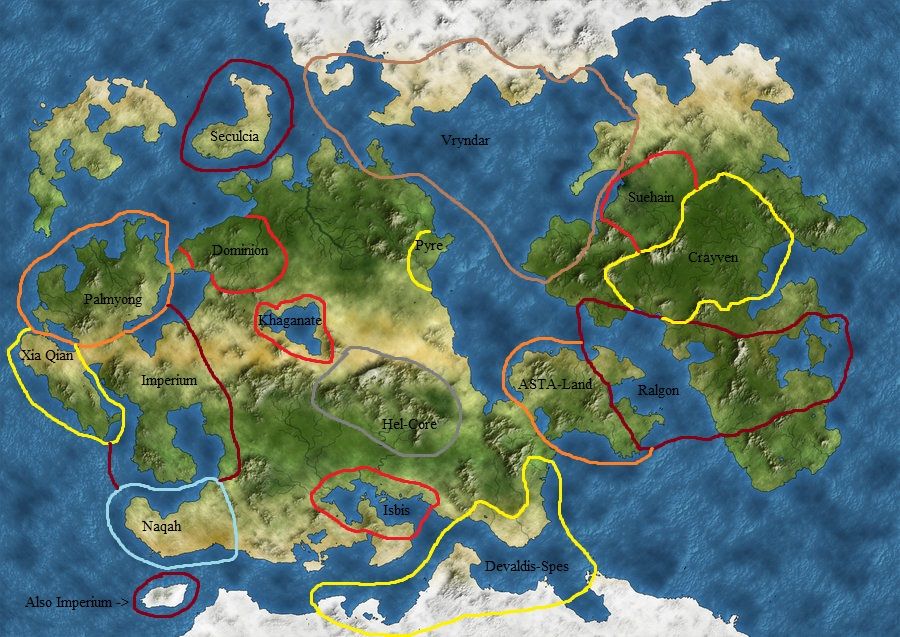


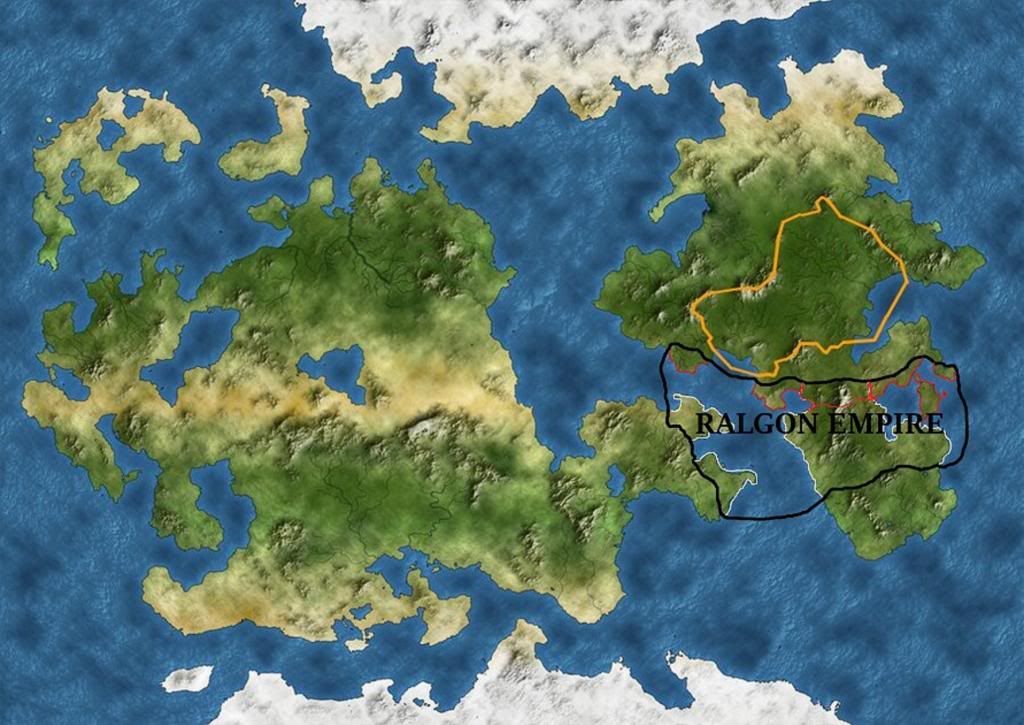

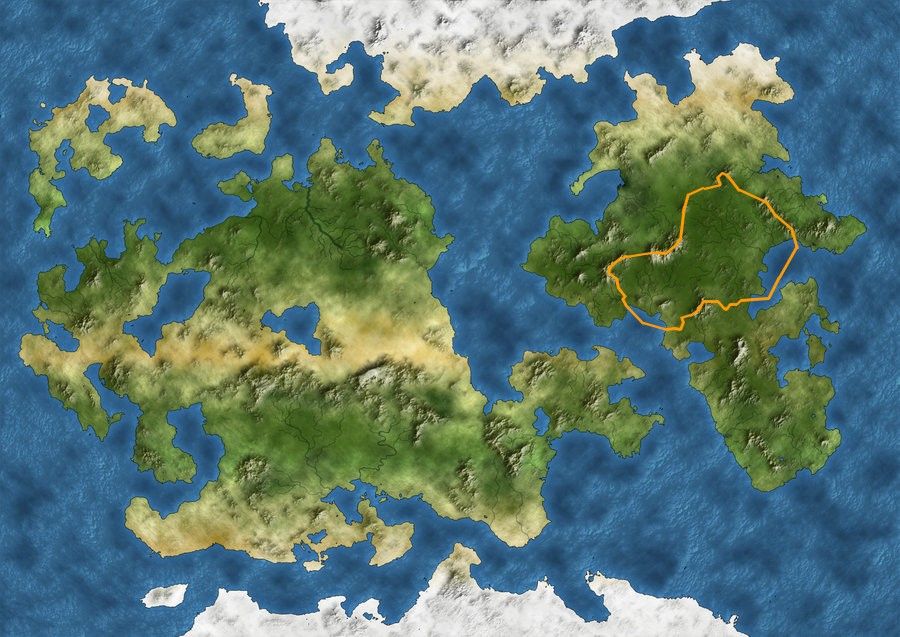

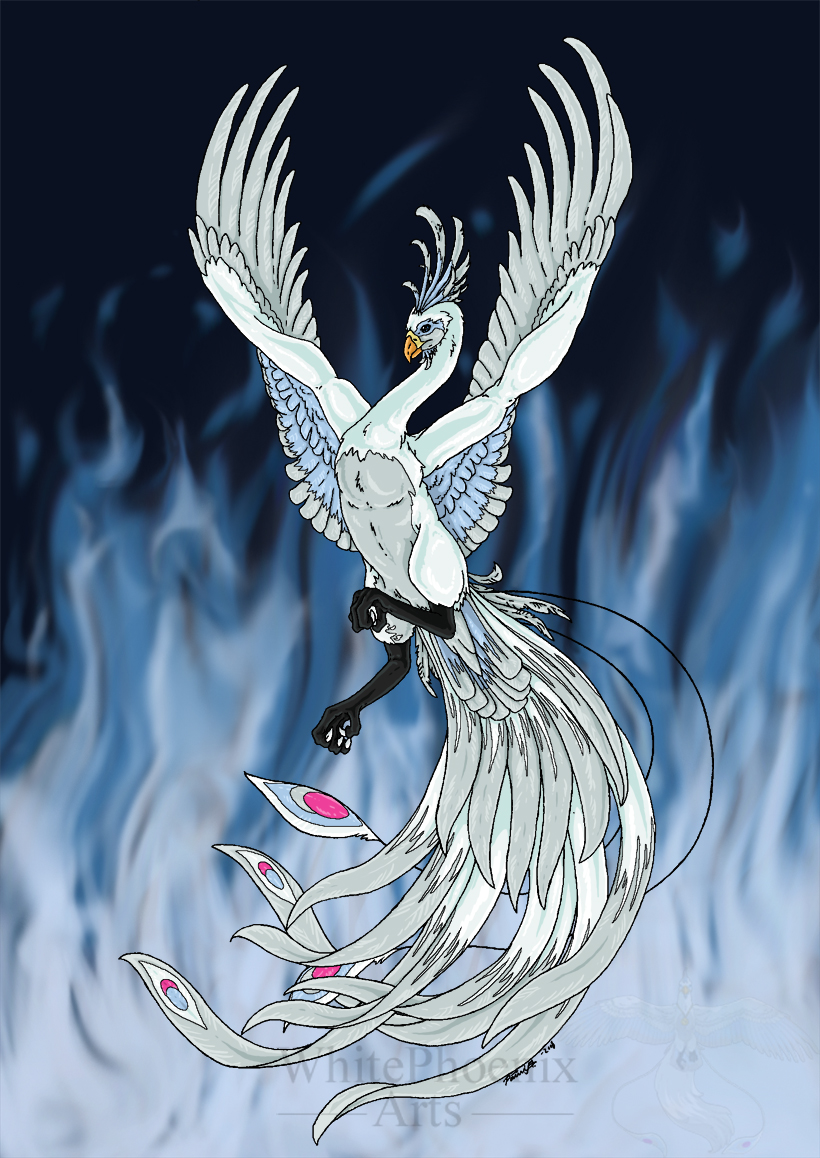
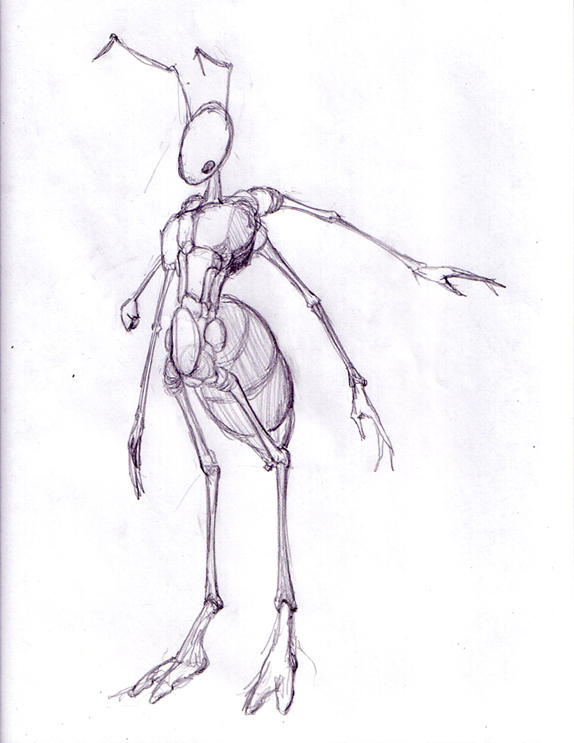



 I'll have more up tomorrow. Also this is cool.
I'll have more up tomorrow. Also this is cool.

